Types of ice shapes
As ice accumulates on a wing, it changes the shape of the airfoil. The ice that forms is sometimes called an "Ice accretion" in the literature. The shape of the ice depends on details of the flight and icing conditions.
At warmer temperatures (about -10°C to 0°C, depending on airspeed and other factors), ice shapes tend to produce "Glaze Ice" shapes with "horns". The nomenclature varies by domain. Pilot training materials generally note this type of ice as "Clear Ice".
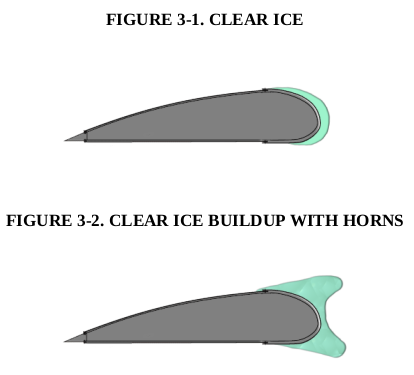
from "Pilot Guide: Flight in Icing Conditions", AC 91-74B faa.gov
At colder temperatures, the ice appears milky and opaque, and is termed "Rime Ice".
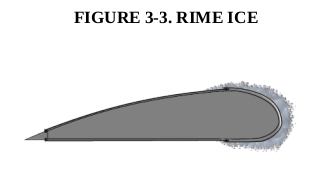
from "Pilot Guide: Flight in Icing Conditions", AC 91-74B faa.gov
At temperatures in between, "Mixed Ice" can form.
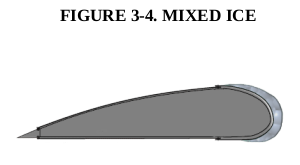
from "Pilot Guide: Flight in Icing Conditions", AC 91-74B faa.gov
These types of ice can have varying effects on lift and drag.
The FAA-H-8083-28, "Aviation Weather Handbook" says of clear or glaze ice can be the most hazardous form:
Clear icing is a more hazardous ice type for many reasons. It tends to form horns near the top and bottom of the airfoils’ leading edge, which greatly affects airflow. This results in an area of disrupted and turbulent airflow that is considerably larger than that caused by rime ice. Since it is clear and difficult to see, the pilot may not be able to quickly recognize that it is occurring. It can be difficult to remove since it can spread beyond the deicing or anti-icing equipment, although in most cases, it is removed nearly completely by deicing devices.
Aircraft features smaller than wings, such as engine components, antennas, and air data probes, generally have a high collection efficiency, regardless of drop size, and can have ice accretions that are a large fraction of the feature size.
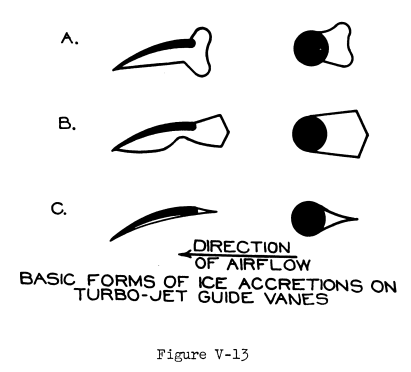
From "Modern Icing Technology", 1952 deepblue.lib.umich.edu
Ice shapes on swept wings can have complex "lobster tail" shapes:
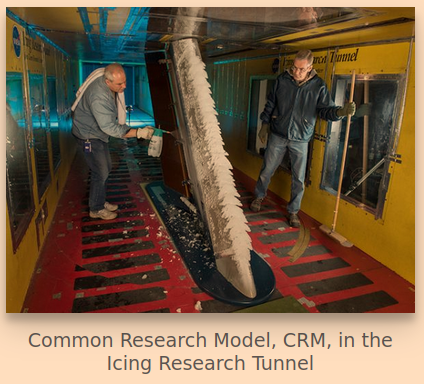
from "Glenn Research Center Icing Research Tunnel Facility Overview" www1.grc.nasa.gov
The thermodynamics of freezing
For liquid water to freeze, heat must flow out of the water. A term for the amount of heat is the "Latent Heat of Fusion". The latent heat value is about 334 kJ/kg. This is much higher than the energy required to cool the water by 1°C (1 kJ/kg).
While supercooled water drops in the atmosphere are below 0°C, the latent heat release and other energy sources tend to raise an aircraft surface temperature to 0°C when water drop impinge on the surface and freeze.
The "Messinger Heat Balance" (from Bernard Messinger in 1951) considers several ways heat enters and leaves a surface in flight with water on it. A large term is the latent heat of freezing. Convection heat transfer (the transfer of heat from the surface to the atmosphere due to the motion of air) is a factor considered. Water on the surface can evaporate, and the "Evaporation" rate is sensitive to air pressure. Evaporation greatly aids the freezing process, as the latent heat of evaporation is almost seven times (2256 kJ/kg) that of the latent heat of freezing, and in opposite sense (freezing produces heat to be removed, evaporation results in cooling). Much detailed data, including the "Water catch" rate, is required to perform the Messinger heat balance.
One term that the Messinger heat balance produces is a "Freezing Fraction", the fraction of impinging water that freezes. This can be related to the over-all character of ice shapes.
Here, freezing fraction ("relatively slow freezing") is related to ice type:
Clear ice (or glaze ice) is a glossy, clear, or translucent ice formed by the relatively slow freezing of large, supercooled water droplets. Clear icing conditions exist more often in an environment with warmer temperatures, higher liquid water contents, and larger droplets.
from "Pilot Guide: Flight in Icing Conditions", AC 91-74B faa.gov
Terms of the Messinger heat balance:
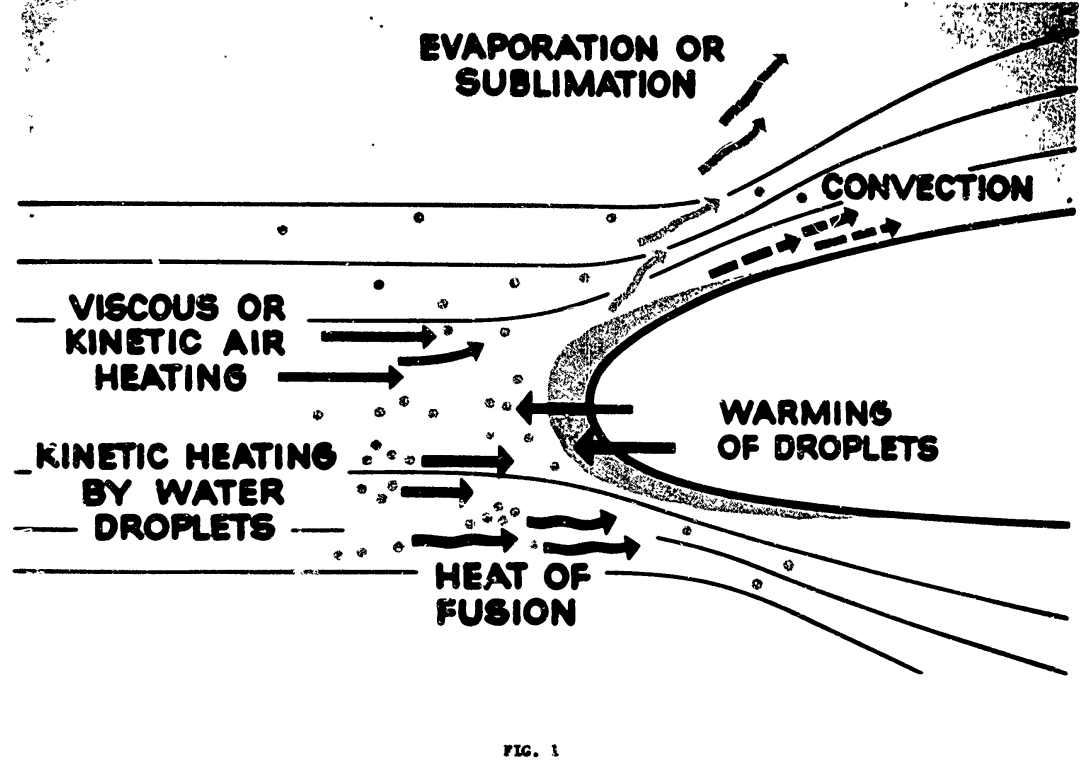
from "Aircraft Ice Protection", the report of a symposium held April 28-30, 1969, by the FAA Flight Standards Service apps.dtic.mil
Calculations to relate ice shape to freezing fraction have many variables. Here is a figure that summarizes the effects of some variables (n is calculated freezing fraction):
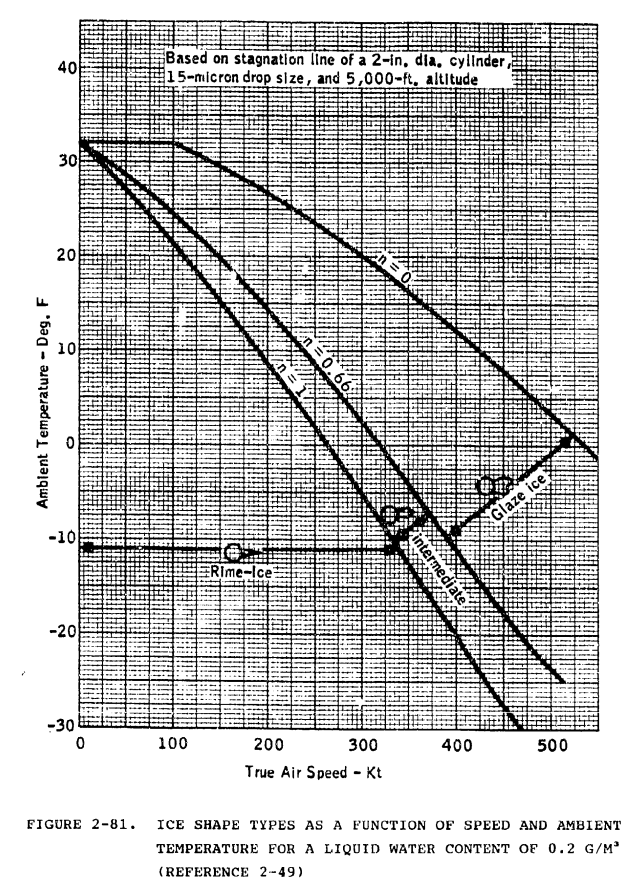
from "Aircraft Icing Handbook", DOT/FAA/CT-88/8 apps.dtic.mil (1991)
Note that at a high enough airspeed, there is a wide range of temperatures that are predicted to not result in ice (n = freezing fraction = 0).
Resources
"Aircraft Icing Handbook", DOT/FAA/CT-88/8 apps.dtic.mil,
Chapter 1, Section 2 in particular.
Also note that there was a perhaps little known update in 1993: apps.dtic.mil The update contains only the updated pages.
This worked fine when one printed the pages, punched holes, and manually substituted them into a three ring binder,
but not so well in the digital age.
I do not know of a pdf file that integrates the two into one.
"Aviation Weather Handbook", FAA-H-8083-28 faa.gov
""Pilot Guide: Flight in Icing Conditions", AC 91-74B faa.gov
Blog series "Ice Shapes and Their Effects"
Messinger, B. L.: "Equilibrium Temperature of an Unheated Icing Surface as a Function of Airspeed. Preprint No. 342, Presented at I.A.S. Meeting, June 27-28, 1951. arc.aiaa.org [Payment or institutional access required]
Chapter V of "Modern Icing Technology" (1952) deepblue.lib.umich.edu has much of the same material as Messinger "Equilibrium Temperature ...", available at no cost.
Blog review of Messinger "Equilibrium Temperature ..."
skybrary.aero article: "Ice Formation on Aircraft"
Related
This is part of The Basics series.